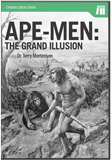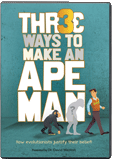
Early Human Beds Discovered In South Africa
Sleep tight and don’t let the bedbugs bite.
News Source
- Science: “Earliest Human Beds Found in South Africa”
If you were camping at a convenient South African cave shelter previously occupied by others, you’d likely wish for a change of bedding and a fresh batch of insect repellant. Apparently the desire for a clean comfortable place to sleep free of vermin has long been a human priority. So suggests Lyn Wadley’s team from their investigation of Sibudu Cave above the Tongati River in South Africa.
Excavation to a ten-foot depth1 has uncovered layers of centimeter-thick mats made of compressed grasses and sedges. The mats are large, as much as 22 square feet.2 Clinging particles of river mud suggest these wet habitat grasses were gathered near the river and brought to the cave’s dry environment high on the cliff-face.
Furthermore, microscopic examination suggests the plant material was repeatedly crushed or trampled. “The evidence strongly suggests that the plant layers were used as a type of floor preparation, usually called ‘bedding’ by archaeologists, but probably used—such as in KwaZulu-Natal [province of South Africa] today—as a surface for working and sleeping.”3 Bits of “chipped stone and crushed, burnt bone” in the layers were consistent with “surfaces where tools were fashioned and food was prepared.”
At intervals there are remains of leaves known for aromatic insecticidal qualities. Furthermore, there are repeated layers of ash and carbonized plant strata indicative of repeated burning. Ash forms at the top of such a burning layer, and carbonization occurs deeper where oxygen is limited. Wadley suspects lodgers periodically burned flooring to rid the cave of vermin and replenished the natural carpeting and insect-repelling leaves. These particular aromatic leaves are effective against many insects including malaria-bearing mosquitos, an endemic problem in much of Africa.
Wadley’s team has been excavating this cave since 1998 and has already found bows, arrows, and other artifacts suggestive of complex modern human culture. The more recent layers have a greater density of stone tool flakes, piles suggestive of swept debris, and a greater density of layers. The researchers believe this change suggests “longer visits, more visits, or larger groups than previously” and “supports an interpretation of greater populations.”4
Previous evidence of bedding elsewhere in the world—Spain, Israel, and South Africa—has been more fragmentary and dated at 20,000 to 30,000 years. The deepest layers of bedding/flooring in Sibudu Cave were dated using optically stimulated luminescence at 77,000 years. Sequential dating of more samples produced a range of dates down to 58,000 years. Thus, Wadley’s team is confident this discovery represents the earliest evidence of human bedding. Furthermore, the younger Middle Stone Age dates correspond to the time evolutionary anthropologists believe the Homo sapiens population grew and began moving out of Africa. These “younger” layers are the ones with indications of increased site usage consistent with population growth.
Optically stimulated luminescence dating (OSL) is a dating method that assesses how much energy is stored in a mineral, assuming its electrons were excited by sunlight in the past, trapped within crystalline imperfections, and kept in the dark ever since. The energy the mineral now emits when stimulated by laser light is compared to emissions from specimens obtained from the present environment. The ratio is used to calculate how long the mineral has been buried.
OSL is based on unverifiable uniformitarian assumptions. Can we know a sample has truly been in the dark for seventy thousand years? Can we be sure heat or water exposure has not altered the energy stored in it? Can we be sure a mineral’s sensitivity to light has remained unchanged? It is impossible to be sure these conditions have been met. Furthermore, results must be calibrated by comparison to other dating methods based on their own unverifiable assumptions. And those dating methods are also used to calibrate molecular clock calculations used in genomic mapping of populations through the ages. Thus the same assumptions are foundational to conclusions about the age of artifacts and the timing of population movements out of Africa. Even the “out of Africa” paradigm is based on unverifiable assumptions, including the presumption humans evolved from apelike ancestors in the first place.
Biblical history reveals people began dispersing throughout the post-Flood world less than 4,300 years ago. The Sibudu Cave with its indications of “complex behavior” would be expected in a world where intelligent people were using their skills to survive. Anthropologists are excited to see this “early” use of herbal medicine among ancient humans. As believers in biblical history, we understand the people who dispersed from Babel were not ignorant brutes. Though some groups lost skills and knowledge over the years, we’re not surprised to see the people who lodged at Sibudu knew how to make the cave into a practical shelter from the elements and the pests. People really haven’t changed much at all.
Further Reading
For More Information: Get Answers
Remember, if you see a news story that might merit some attention, let us know about it! (Note: if the story originates from the Associated Press, FOX News, MSNBC, the New York Times, or another major national media outlet, we will most likely have already heard about it.) And thanks to all of our readers who have submitted great news tips to us. If you didn’t catch all the latest News to Know, why not take a look to see what you’ve missed?
(Please note that links will take you directly to the source. Answers in Genesis is not responsible for content on the websites to which we refer. For more information, please see our Privacy Policy.)
Footnotes
- “World’s Oldest Bedding Discovered in Cave,” Yahoo! News, December 8, 2011, https://www.yahoo.com/news/worlds-oldest-bedding-discovered-cave-190303977.html
- James Owen, “Oldest Known Mattress Found; Slept Whole Family,” National Geographic, December 10, 2011, http://news.nationalgeographic.com/news/2011/11/111208-oldest-mattress-africa-archaeology-science.
- Lyn Wadley et al., “Middle Stone Age Bedding Construction and Settlement Patterns at Subidu, South Africa,” Science 334, no. 6061 (December 9, 2011): 1388–1391, doi:10.1126/science.1213317.
- Ibid.
Recommended Resources

Answers in Genesis is an apologetics ministry, dedicated to helping Christians defend their faith and proclaim the good news of Jesus Christ.
- Customer Service 800.778.3390
- © 2024 Answers in Genesis







